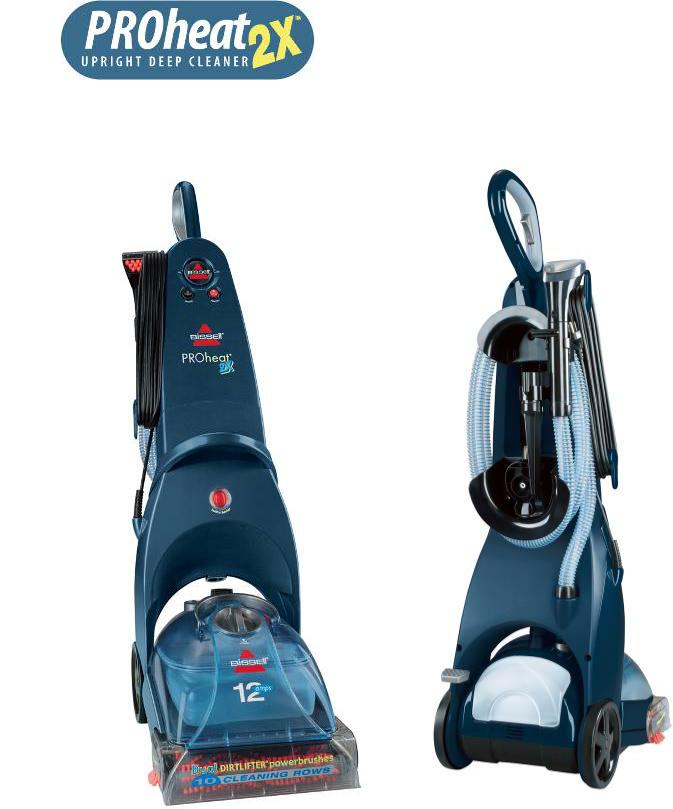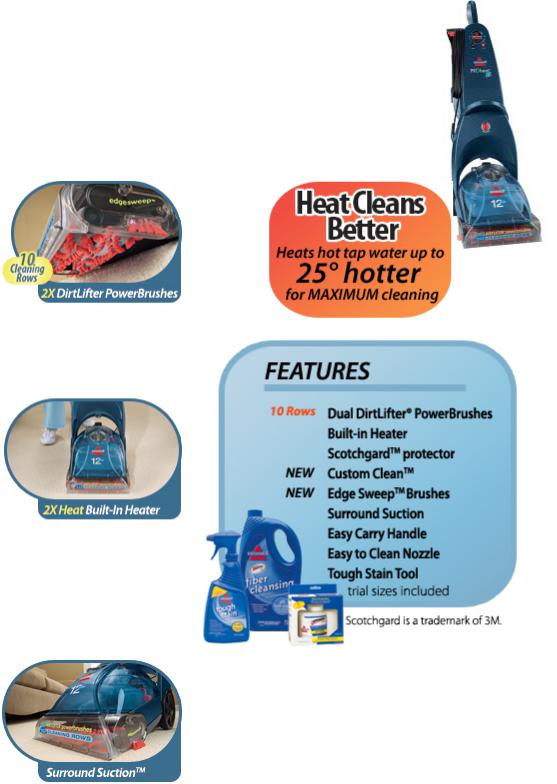Bissell 8920 Service Manual

Bissell ProHeat 2X™ Service Center Guide
Series 8920, 9200, 9300, 9400
Service Center Guide
Issued: September, 2005 |
|
© 2005 BISSELL Homecare, Inc. |
Page 1 of 22 |
Bissell ProHeat 2X™ Service Center Guide
TABLE OF CONTENTS
Product overview |
Page 3 |
Quick reference troubleshooting chart |
Page 4 |
UL recommended high voltage test |
Page 5 |
Ground continuity test |
Page 5 |
Using a servicing platform |
Page 5 |
Preliminary diagnostic checks |
Page 6 |
Functional systems checks |
Page 6 |
Troubleshooting low/no spray symptoms |
Pages 7-8 |
Troubleshooting low suction symptoms |
Page 8 |
Troubleshooting brush motor |
Page 9-10 |
Taking the unit apart |
Pages 11-13 |
Replacing the pump |
Page 14 |
Replacing the solenoid in the base |
Page 14-15 |
Replacing the heater |
Page 15 |
Replacing the vacuum motor |
Pages 16 |
Replacing the brush motor |
Pages 17-18 |
Replacing the bridge rectifier |
Page 19 |
Replacing the micro switch |
Page 19 |
Wiring diagram - BISSELL ProHeat 2X™ |
Page 20 |
Wiring diagram - BISSELL ProHeat 2X™ Select |
Page 21 |
Plumbing diagram |
Page 22 |
Issued: September, 2005 |
|
© 2005 BISSELL Homecare, Inc. |
Page 2 of 22 |

Bissell ProHeat 2X™ Service Center Guide
PRODUCT OVERVIEW
ProHeat 2X™ is the new revolutionary new cleaning system featuring:
•Dual DirtLifter® PowerBrushes.
•New SmartClean™ solution mixing.
•Heated cleaning at the floor and through the attachment hose.
Gets the deep down dirt and leaves your carpets beautifully groomed
Heats hot tap water up to 25 degrees hotter for maximum cleaning. Now heats through the attachment hose too!
Edge to edge cleaning and suction power
Issued: September, 2005 |
|
© 2005 BISSELL Homecare, Inc. |
Page 3 of 22 |
|
|
Bissell ProHeat 2X™ Service Center Guide |
Quick reference troubleshooting chart |
||
Problem |
|
Possible cause / Check for… |
• Low/No spray to floor and |
• |
Tank is warped and/or not sealing properly |
upholstery hose |
• |
pinched/clogged line |
|
• |
defective bridge rectifier |
|
• |
defective pump |
|
• faulty auto load receiver |
|
|
• defective component allowing air into system |
|
|
• pump not mounted so it can move freely |
|
|
• |
clogged heater |
|
• |
defective circuit board |
• Spray through hose but not to the |
• |
clogged spray tips |
floor |
• |
defective solenoid valve in the base |
|
|
(if solenoid is defective, the heater is to be |
|
|
replaced as well) |
|
• defective trigger microswitch in upper handle |
|
• Pump motor does not run |
• |
defective rectifier |
|
• |
defective motor |
•Unit does not spray solution, only water
•Good spray for a couple of seconds then dies off
•Bubbles coming into the water tank from auto load assembly
•defective auto load receiver or solution tank
•defective manifold assembly
•kinked tube
•tanks not completely inserted into receiver
•bad weld on auto load receiver
• Large bubbles in upholstery hose |
• |
defective pump |
• Both brushes not spinning |
• |
left side belt broken |
|
• |
defective micro switch |
|
• |
defective brush motor |
|
• |
defective circuit board |
• Front brush not spinning |
• |
right side belt broken |
• Brush is noisy (rattles) |
• |
bushings have spun in dowel |
• Low suction |
• |
clogged filter or clogged air path |
|
• |
stuck float |
Issued: September, 2005 |
|
|
© 2005 BISSELL Homecare, Inc. |
|
Page 4 of 22 |
Bissell ProHeat 2X™ Service Center Guide
UL RECOMMENDED HIGH VOLTAGE TEST
In keeping with UL standards, a high voltage test should be performed on a vacuum or deep cleaner any time the unit is in for repair, particularly when the motor or other electrical components have been replaced. High voltage testing is done for the safety of the customer. By applying an over-voltage between "live" parts and various metal portions of the machine that are exposed to wear, you proof-test the entire machine against grounds or shorts that could cause inconvenience, fires, or personal injury. High voltage testing is also a quality control measure. The possible future failure in the insulation of any portion of the unit, whether due to workmanship, components, or materials, will be detected by this procedure prior to return of the unit back to the customer.
The normal test parameters are 1000 volts for one minute. There must be no indication of dielectric breakdown at the uppermost values. After the unit is completely assembled, the high voltage test required is the power cord to terminals in plug with the product switch on "on" position. This test can be accomplished with any commercially available test equipment offered for this purpose. The following testers are recommended:
Associated Research - Model 4025 or 4050 AJ
Slaughter - Model Series 2306 or 2307
Beckman Ind. (Rosemont) Model P-9A
GROUND CONTINUITY TEST
This test is performed to determine that grounding continuity exists between the grounding blade of the lower supply cord plug and the motor. This test should be performed any time electrical connections are disturbed. Any suitable indicating device - ohmmeter, battery/buzzer combination or the like may be used to determine compliance. Contact points are the ground terminal and the plug to the shaft of the vacuum motor and the heater body.
USING A SERVICING PLATFORM
Begin by placing the unit on a servicing platform. Servicing Platform should fit securely under the unit and raise its wheels off the workbench surface.
Issued: September, 2005 |
|
© 2005 BISSELL Homecare, Inc. |
Page 5 of 22 |
Bissell ProHeat 2X™ Service Center Guide
PRELIMINARY DIAGNOSTIC CHECKS
Check to make sure the unit is properly assembled.
Check seals on the Clean Water/Recovery Tank, Formula tank, Rear Cover, and Nozzle. If necessary, re-seat or replace seals.
Check valve action on Clean Water/Recovery Tank and Formula tank by depressing them with your finger. The valve should move up and down. Replace if necessary.
Check position and condition of all gaskets and seals. Re-seat or replace if necessary.
Rotate front brush to determine if rear brush also spins. Both should rotate smoothly and quietly.
FUNCTIONAL SYSTEMS CHECKS
**If any of these functions do not work, refer to the quick reference troubleshooting guide on page 4 for a list of possible causes and things to look for. Then follow the related troubleshooting steps in the rest of this guide.
Place the filled solution and water tanks onto the unit.
Set SmartClean™ knob to normal.
Plug in unit and turn it on.
Listen for unusual motor noise such as grinding, racing, louder than normal, etc. If so, remove and replace the vacuum motor.
Depress main handle trigger and check for spray at unit bottom.
Depress upholstery hose trigger and check for spray at hose.
Make sure both brushes spin.
Check suction at vacuum duct.
Issued: September, 2005 |
|
© 2005 BISSELL Homecare, Inc. |
Page 6 of 22 |
Bissell ProHeat 2X™ Service Center Guide
TROUBLESHOOTING LOW/NO SPRAY SYMPTOMS
With the SmartClean™ dial set to rinse insert the formula tank into the unit in place of the water tank in the front auto load receiver. Do not put the tank in the rear auto load receiver. The rear auto load receiver may remain empty as long as the unit is set to rinse. Putting the smaller formula tank in the front receiver leaves more room to see the receiver is making proper contact with the cap and insert. Turn the unit on and see if it sprays. If it does the tank is warped and needs to be replaced.
Place the filled solution and water tanks onto the unit.
Look for bubbles coming into the water tank. If bubbles are coming into the tank from the auto load receiver, the receiver may have a bad welded seam. Replace the auto load receiver.
Plug unit in and turn it on.
Turn the SmartClean™ setting to rinse. The rinse setting is a positive off and will eliminate the formula tank from the spray system so that the pump will only draw from the water tank. If the unit will spray when set to rinse but not when set to normal there may be something wrong with the formula tank, auto load receiver, or seal.
Turn unit off.
Remove the recovery tank top, place recovery tank bottom back on unit, turn unit back on, and check for spray. The recovery tank becomes negatively pressurized when the unit is running. Removing the top eliminates that pressure and makes it easier for the pump to work. The pump is likely faulty if the unit will not spray with the top on but will spray after it is removed.
**If the unit is equipped with solenoid valves that operate the SmartClean™ system you may want to check their operation and assembly before removing the access cover.
Refer to the section on "TAKING THE UNIT APART" beginning on page 11 before proceeding.
Check operation of the solenoid valves. Pulling the trigger should energize the solenoid that is located in the base of the unit next to the heater (110 volts should be sent to each solenoid valve after it is energized). Some units will also have two solenoids as part of the SmartClean™ system. Switching the SmartClean™ dial to high traffic should energize both of those solenoids.
Check all internal components to ensure proper assembly.
Issued: September, 2005 |
|
© 2005 BISSELL Homecare, Inc. |
Page 7 of 22 |
